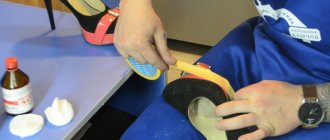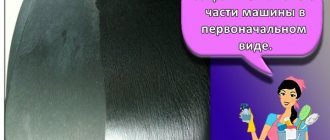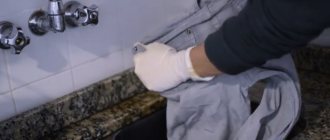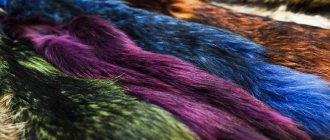Share on social media networks:
Many people have an old but favorite T-shirt in their closet at home that they hate to throw away. There are many ways to use old things - use them for rags or sew a toy, etc. But what if you want to wear a T-shirt, but there is a stain on it or it has lost color? Just paint! Anyone who has encountered such a problem has wondered how to dye a T-shirt at home? In order to begin the painting procedure, you need to find out about painting methods and other details. This is what we will do in this article.
Dyeing an old T-shirt
How to color a T-shirt using the tie dye technique or decorate it with a beautiful pattern? Dyeing a T-shirt is not a labor-intensive process, especially if you have all the necessary tools and materials on hand. To get started, you will need:
- White cotton T-shirt.
- Dye.
- Water.
- Rubber.
- A bowl.
Almost all T-shirts and tank tops are made from cotton fabric, so the dye adheres to them well. Paint can be purchased at any store or market.
Important! If you do not trust chemical coloring compounds, you can use natural dyes (berries, onion peels, iodine, brilliant green).
Is it possible to paint fabric with gouache?
Gouache for coloring can only be used if mixed with glue. Before carrying out the procedure, it is necessary to combine paint and glue in equal proportions. If you need to obtain a shade that is not in the palette, you should mix the colors, only after that glue is added.
If the result is unsatisfactory, traces of paint are removed by regular washing. After completing the work, apply a layer of varnish to the drawing.
The mixture is applied with a brush; after applying each element, the tool should be wiped. A three-dimensional picture is obtained by applying a thick layer, a flat picture is obtained by rubbing in the coloring matter.
A simple way to paint
We paint with natural substances:
- Bring a natural dye (for example, chamomile) to a boil and strain through cheesecloth.
- The T-shirt needs to be twisted into a tight rope and assembled in such a way as to form a ball.
- Then we fix the product with rubber bands and place it in a container with dye, leaving it for at least an hour.
- The item should dry indoors on a clean cloth.
Important! You can secure the T-shirt with elastic bands in any way you like - the more difficult you secure the elastic band, the more interesting the pattern will be.
Colors from natural dyes
What are natural fabric dyes? This is a pigment that is found in plants. As a rule, it is harmless, but some can have a really good effect. The saturation of the coating will be no worse than that of a chemical one, but the price and usefulness are much higher.
Beige and cream
Usually these colors are needed to remove or soften the “yellowness”. White fabrics often turn yellow over time and this is an unpleasant effect that needs to be removed. Regular tea or coffee will help with this.
In the case of coffee, you will need the most common freeze-dried and instant coffee. According to reviews, Jacobs and Nescafe are best. They contain a lot of pigment, so coloring will happen very quickly.
It is worth noting that this tinting is permanent. After washing, the tone will not change, so many people use this affordable method. But there is another feature here: concentration. Depending on the amount of coffee in the solution, the tone will have different richness. It’s better to choose the proportions in advance and practice on pieces of unnecessary white fabric.
There are also coloring products in tea. But the situation with him is different. Here you will need tea with very good brewing ability. It needs to release all the dye directly into the water, so packaged Lipton, for example, will not work.
Yellow
Birch leaves are often used for this. The tone is surprisingly bright and rich. Yellow fabric dye can also be pastel. The roots and bark of a barberry bush are well suited for this. But, since this plant is not widespread, the method is rarely used.
Buckthorn bark is also a good toner. Moreover, depending on its humidity, the shade will be different. Fresh gives a beautiful yellow tone, stable and long lasting. Dry color creates a shade closer to brown.
Wormwood perfectly colors the canvas straw-like. But most often it is mixed with alum. This way you can achieve a lemon color.
Blue
Berries come into play here. Since dyeing fabric at home takes a long time, blueberries and blackberries are suitable. These berries have a very corrosive natural pigment that cannot even be washed off by hand. It turns out a beautiful shade that is quite suitable for youth clothing. But there are also difficulties - uniformity. It is almost impossible to achieve uniform coloring, since in some places there will be more juice and in others less. Even subsequent washing does not help with this. You can also add black currants.
In this case, you can take the herb Ivan da Maria. Their natural colors adhere very well to fabric. The flowers are succulent and pigment is easy to obtain. At high concentrations, the color will become deep blue.
Ordinary brilliant green also shows good results. In a concentrated state it is green, but when diluted it takes on a bluish tone. Such fabric paints are weak and will not give a strong shade. But you can get a bluish flair.
Green
Juniper berries are great for fabric as a dye. But, unlike other berries, it is not easy to pick up the pigment. Digestion with increasing concentration will be required. This is the only way to give clothes or sheets a rich color.
Green is an accessible and simple pigment. Parsley, arugula, spinach, sorrel, and cilantro contain a lot of rich paint that will easily transfer to fabric. But you need to be careful here, as spinach and sorrel contain acid, which can damage the threads.
An even simpler option is the same brilliant green. You just need to dilute it in water and put the thing in there. You can’t just paint with brilliant green - the color will turn out uneven and cloudy.
Red
How to get red? Any red berries are perfect as a dye. But, in order not to waste strawberries or raspberries, it is better to take elderberry. Its pigment is much stronger and more powerful compared to other berries, and the price is lower. It is suitable if the color should be as bright and saturated as possible.
Onion peels (as for Easter eggs) will color the canvas in a red-brown tone. This will create uniform toning. Such natural dyes are also highly valued due to their stability. It will be impossible to remove the paint and the item will remain red-brown forever.
Orange
There are practically no orange pigments, so the only option is sea buckthorn. But it’s enough to tint an entire duvet cover. Sea buckthorn dye is very bright, it penetrates very deeply into the structure of the thread and is practically not washed out.
It can be adjusted. Lemon and orange zest will help soften the tone a little. Together they give a slight decrease in the intensity of the shade. You can also dye fabrics using only the zest. But then the effect will be weak.
Unusual colors
In addition to standard colors, it is quite possible to create other, more interesting and unusual colors.
- Mustard. Very beautiful and discreet tone. It cannot be made with mustard powder, since it does not have coloring properties. But it is quite possible to do this with turmeric. It is important to choose the right concentration so that the shade is not faded, but not too bright.
- Spicy. To do this you will need cinnamon, either in powder form or with a stick. It needs to be boiled well in water, and then put the fabric there. The broth will nourish the pores of the threads and the color will be long lasting.
Dyeing a T-shirt at home
In order to paint a T-shirt at home, you should carry out several manipulations:
- Place the T-shirt in a bowl or other container.
- Use a syringe to apply dye to one side and then to the other.
- Rinse the item several times in clean water.
- Dry the painted product.
- Iron the item to secure the pattern.
Important! To make the design brighter and more colorful, spread the dye over the surface of the T-shirt with a brush.
Paint a T-shirt with acrylic dye
Acrylic paints are considered one of the best dye options for clothing. They penetrate perfectly into fabric fibers and have a wide range of shades. In addition, now in the markets you can find pearlescent colors and shades that glow in the dark.
To paint a T-shirt with acrylic dye, you will need:
- Acrylic dye of the desired shade.
- Synthetic brushes.
- Sheets of cardboard.
- A simple pencil.
Let's start dyeing the T-shirt:
- Place a sheet of thick cardboard inside the T-shirt. This is necessary for high-quality drawing.
- Using the template, draw the outlines of the design on the front side of the T-shirt with a simple pencil.
- Dilute the acrylic dye with water, as its consistency is too thick.
- Start coloring the drawing with dye using brushes.
- Leave the item to dry completely.
- Iron the T-shirt through cheesecloth to secure the design.
Don't worry if you drip paint outside the outline of the design. Show your imagination and make an interesting pattern out of colorful spots.
Important! After applying acrylic paint, the item cannot be washed for two days.
Making a T-shirt using the Tie-Dye technique
The Tie-Dai technique has gained popularity since ancient times in China and India. It represents bright extraordinary patterns on things. Today it is used by many global clothing brands.
In order to dye clothes using this technique, you will need the following materials and tools:
- White shirt.
- Plastic containers.
- Water.
- Dye.
- Strong threads.
- Salt.
After you have acquired all the necessary materials, start creating:
- Twist the T-shirt into a spiral and wrap it around its axis several times.
- Secure it with threads.
- Pour warm water into a plastic container.
- Dilute the dye and a tablespoon of salt with warm water.
- Apply paint to the T-shirt using a brush.
- Leave the item for a day to dry thoroughly.
Important! The T-shirt should be dried in a dry place away from moisture, as the pattern may not stick.
Dyeing a T-shirt black
One of the easiest methods for dyeing old T-shirts is to dye them a uniform (black) shade. To freshen up an old black T-shirt, you will need:
- Enameled bowl.
- Black paint.
Let's start painting:
- Place the paint packet in a small saucepan and add a little water.
- Stir until a paste forms.
- Pour 500 ml of cold water into the resulting paste.
- Mix everything and strain through a fine cloth.
- Pour the entire solution into a bowl, add water (temperature at least 50 degrees).
- Place the jersey in a bowl and place over low heat.
- After boiling, add one tablespoon of salt.
- When the water with the dye boils for the second time, remove the container from the heat and place it in a dark place.
- Rinse the T-shirt several times with hot and then cool water.
- Dry the product and iron thoroughly.
Important! The product must be kept in water with dye for at least 30 minutes.
Making a multi-colored T-shirt
In order to decorate a T-shirt with different colors, you will need:
- Dye.
- Rubber bands.
- Deep capacity.
- Salt.
- Protective gloves.
- Clothespins.
First you will need to wet the T-shirt, and then twist it around its axis - into a ball. Place the item in the prepared dye solution. Leave the shirt on for about an hour. After an hour, rinse the clothes in cold water until the water runs clear.
Important! If you want to get a pattern in the form of longitudinal lines, then twist the T-shirt with an accordion and secure it with clothespins.
Coloring techniques
In addition to solid dyeing, there are several methods to transform a T-shirt beyond recognition, even applying a pattern using the batik technique. Clothes dyed using tie-dye, gradient, knotted or ombre techniques are again at the peak of popularity.
Uniform, whole product
To obtain a uniform color, the pigment is gradually diluted with water and stirred until all grains disappear completely. If you cannot get rid of them, then the diluted paint must be filtered through cheesecloth. The staining itself is carried out according to the manufacturer's instructions.
Bleach
It is very easy to dye a T-shirt white using the old method, which has been known since the 90s of the last century. This is exactly how “varenki” were made at home. The T-shirt is rolled up, similar to how one would twist it, tied with string, and boiled in a mixture of water and bleach.
Important! To dye with white, it is recommended to use things with a natural fiber composition. As a last resort, synthetic fibers should not exceed 20%.
A faster way - without boiling. The T-shirt is twisted randomly, tied and filled with white, left for 10 minutes until the desired result is obtained, then washed.
Tai Dai
Things dyed using the tie dye technique resemble the wardrobe items of real hippies. The term is translated from English as “tie-dye”, which perfectly reflects the essence of the method.
Step by step process:
- washing a T-shirt;
- do not dry, lay out when wet on a flat surface;
- place a fork in the middle and screw the item onto it;
- use elastic bands (3-4 pieces) to tighten the T-shirt;
- dilute the paints according to the instructions;
- Apply paint to the sectors marked with rubber bands.
Next, you need to follow the instructions specified in the instructions. Typically it takes 6-8 hours to dye. At this time, the T-shirt is sent to a sealed bag.
painting
Acrylic paints are used to apply drawings, inscriptions, and ornaments. The T-shirt is placed on a flat surface, with thick cardboard or plastic placed between the back and front sides so that the design does not print. Draw the outline with a pencil according to the selected template, which can be found on the Internet and printed. Then they begin to color the drawn drawing.
Once the paint is completely dry, it is recommended to iron the design through gauze. Washing items is allowed only 2 days after the design is applied.
Dyeing different materials
In order not to make a mistake with the choice of dye and method, it is worth learning how to dye fabric at home.
Cotton
It fades quickly and fades. You will need durable cotton dye and soft water, melt or rain. How to dye cotton fabric:
- store-bought product is diluted in accordance with the specified proportions; the composition is heated to 50 degrees, the item is poured; cook for 20 minutes, add calcined salt; continue cooking for 35 minutes; take out and rinse with warm water.
At the end, the cotton fabric is rinsed at a cool temperature with the addition of a 5 liter spoon of vinegar.
How to dye a cotton jacket: the principle is the same, but add a few tablespoons of salt after boiling. This is necessary to reduce shedding.
Fabric paint, how to use with flax fibers:
- throw the pigment into the water and mix; place the item and cook for half an hour with the addition of a spoonful of salt; the finished product is rinsed with cold water and vinegar; it is wrung out and laid out on a towel.
How to dye wool
How to dye: Aniline dye is best.
How to dye a woolen item at home:
- one sachet is dissolved in 0.5 liters of water; add warm water to the composition; place the product in the container and wait until it boils; after 25 minutes, add 75 ml of acetic acid.
How to dye fabric brown: boil it in onion peels at the rate of 400 g of peel per 100 wool. Rinse in the same way.
How to choose chemical dyes?
You can buy regular white T-shirts in the store, dye them in different ways and make a unique set that others will mistake for designer work. It is better for an inexperienced housewife not to take on complex tasks: painting jackets or synthetic fabrics. Entrust this task to dry cleaning specialists, and start learning yourself with the ABC book: change the color of a white cotton T-shirt. It is more difficult to dye colored things; it is better not to change their color, but simply make it richer and brighter.
In the store you can find dyes of any shade. When buying a chemical, look at what it can be used for. You can treat curtains with any substance, and if you want to dye clothes or bed linen, the composition should not contain compounds harmful to the skin. If there is no label or tag on the item, you can determine the composition of the fabric yourself. If you set fire to linen or cotton thread, it will burn with a burnt paper smell. Burnt natural wool smells like burnt horn, and a ball of combustion products appears at the end of the synthetic thread.
When choosing a dye shade, you need to take into account the original color of the fabric. If you dip a yellow T-shirt in blue pigment, don't be surprised if the result is a greenish-colored item. It is almost impossible to dye a dark product in light colors; you will have to use a very aggressive bleach, which can destroy the structure of the fabric. It is better to paint faded dark clothes black; the pigment will return brightness and freshness to things.
Experts believe that any shade can be obtained using only 3 dyes: blue, yellow and red. Experiment and you can get a whole range of colors by combining these three paints.
The most common colors can be obtained as follows:
- yellow and blue will give green;
- red and yellow will turn to orange;
- red and blue will give a purple tint.











